Review: Great Wall P-61B “Lady In The Dark”
Since it seems P-61s are suddenly popular here, I'm posting the review I did of the Great Wall Hobby kit at Modeling Madness a few years back, which may be of assistance to people. You can cut to the chase at the end which may save you both money and time.
History:
The Northrop P-61 Black Widow is the only designed-for-the-purpose night fighter to ever see operational service. Yes, the He-219 was produced as a night fighter only, but that airplane began life as a project to create an advanced twin engine Zerstoerer successor to the Bf-110. The Northrop P-61 was always and forever intended as a radar-equipped night fighter from the first time the Army Air Forces approached Northrop with the idea in 1940, following provision of all information on radar-equipped night fighters being provided to the USAAC by the RAF.
By the time the P-61 appeared in service in 1944, there was little call for its services, since the Axis air forces were by then mere shadows of their former selves. When the airplane first appeared in the ETO, it was rejected in favor of the USAAF night fighter squadrons being equipped with advanced Mosquito night fighters. A fly-off was demanded by the P-61 crews, and amazingly enough the P-61 was “superior” to the Mosquito. The USAAF always thought that the British had “cooked the books” in the fly-off, since they wanted to keep Mosquito night fighter production for themselves.
Over Northwestern Europe, the P-61s went after German night attack aircraft, with their primary victims being Ju-88s and Ju-87s, with several Ju-52 aircraft on night resupply missions being shot down. In the Mediterranean, there was no night air opposition by the time the P-61 replaced Bristol Beaufighter VI night fighters. In the Pacific, P-61s defended the airfields in the Marianas, at Iwo Jima and at Okinawa. The airplane suffered the ignominy of being replaced by Marine F6F Hellcat night fighters in the Philippines in the aftermath of the 1944 invasion, with the Hellcats being demonstrated superior to the P-61s.
One of the more interesting stories about the P-61 involves the P-61B “Lady in the Dark,” operated by the 548th NFS from Iwo Jima from April 1945 to the end of the war. On the night of August 14, 1945, “Lady in the Dark” was flown by a different crew from that regularly assigned. Vectored onto a bogie inbound at low altitude, the P-61B scored a victory when the Japanese fighter hit the water and exploded without a single round being fired. Officially, the war in the Pacific ended at midnight, but the possibility of night kamikaze attacks against American airfields remained and the P‑61s were kept on alert.
On the first night of “peace” in the Pacific since Pearl Harbor, Captain Lee Kendall took off at 1910 for a routine patrol. 45 minutes later, Iwo Jima ground control reported a bogey approaching the P‑61 at an altitude of 4,500 feet. Contact was quickly established, with Kendall's radar observer picking up “window” several times, meaning the intruder was using defensive tactics as he got closer to Iwo Jima. As “Lady in the Dark” closed, the intruder demonstrated awareness of the presence of the night fighter by making hard turns in an effort to shake any pursuit.
As Kendall recalled years later to an interviewer: "Getting close enough for a positive identification proved to be difficult. He was taking violent evasive action and dropping window, which was bundles of tinsel‑like strips of aluminum foil designed to confuse our radar. This guy knew we were behind him but I have no idea how he knew. My R/O, Lieutenant Scheerer, was talking me in closer to about 800 feet when all of a sudden the left side pilot's window popped open and the rush of air drowned out the communications with him. Down this low at such a high speed and not being able to understand my observer was very unhealthy.”
"I had to back off, secure the window and then get back in touch with him. In the meantime, I lost contact with the bogey, but quickly picked him up again and was able to close on his tail again despite his defensive moves. I had one eye on my target and one eye on my altimeter. Suddenly, the window popped open again and once again I closed it, and as I picked him up for a third time the same thing happened again! Regardless, I went after him for a fourth time and control gave me permission to shoot him down even though we didn't have a positive identification."
Kendall's R/O locked on, but a few seconds later the bogey completely disappeared off the scope and no more window was detected. According to witnesses on the ground, the intruder, a Nakajima Ki.44 “Tojo”, crashed and the debris was scattered over a wide area. This was not listed as an official victory since the war was officially over, but the fact remains that “Lady in the Dark” scored the final two aerial victories of World War II without firing its guns.
The Kit:
When this kit was released, there was quite a bit of criticism of the propellers, cowlings and engines not being accurate. Among several aftermarket resin companies, True Details released a set which includes a different front section for the R-2800s with the magnetos, separate spinners and propeller blades, and corrected engine cowlings.
I am informed by Lion Roar, the company that produces this kit, that all those items were corrected and replaced in their later release of this kit following the initial release. Photos I have seen of the engine and cowling do show the corrections. The prop is still in one piece with spinner and blades, but the shape of the blades has been improved. They also included the clear nose part for the P-61A which had been provided in early review kits but not in production kits. The problem for a modeler is figuring out if the kit they have purchased is one of the initial release with the inaccurate parts. The old kit is L4802 while the new corrected kit is L4806.
An additional inaccuracy is that the nose gear leg is too short, which results in a nose-down “sit” which is inaccurate. I worked with Ross McDonald of Scale Aircraft Conversions and Terry Dean to create a master gear leg of the proper length, which is now available in all Scale Aircraft Conversions P-61 sets; modelers who bought the set before this change was made can obtain the correct part from SAC.
Zotz Decals released another of their excellent sheets, with decals for several P-61A and P-61B Black Widows, including “Lady in the Dark.” The sheet is very accurate, and is the only one to include the markings information for “Lady in the Dark” in her later markings with red spinner and cowling flaps. Eli even went so far as to discover that pilot Lee Kendall changed his name from Sol Colomon to Kendall in 1962.
Construction:
Since my kit had arrived with the P-61B nose rather than the P-61A nose, I decided I would make a P-61B. My first thought was to use the turret from the old Monogram kit, but “Mr. P-61", Terry Dean, informed me that most of the P-61Bs that saw combat used a barbette rather than a turret (since the four-gun turrets were in high demand for B-29s). Terry makes a resin barbette, which I decided to use along with his nose weights, which are crucial if one wants to have a nost-sitter model with a minimum of hassle. Terry was also generous enough to send along the Zotz decals for “Lady in the Dark.”
One thing that is unchanged whether one has an early-release or a late-release kit is that the position of the pilot's instrument panel and the seat and controls is wrong. Also, the control yoke is too big. One needs to move the instrument panel 1/8 inch to the rear (even with the coaming), while moving the seat and control yoke 1/8 inch forward. As to the yoke, if you have the old Monogram kit, the pilot's control yoke is the right size. Additionally, the gunner and radar operators positions do not have the gun control; again, these can be sourced from the old Monogram kit. (Editor's note: The kit Tom used did not come with a turret. This and the controls are in the second boxing.)
Also, if you are doing a P-61B, remember to cut the main gear doors along the engraved line, so the rear panels can be closed.
Since I had the old Monogram kit available, I decided I would do some sub-assemblies of that kit and compare them with this new kit. Throughout, the new kit fits better, and requires little if any putty or surfacer to fill seams, and there are no gaps when attaching wings to fuselage nacelle, or engine booms to wings, which there are with the Monogram kit. Whether this ease of assembly is worth a price that is 3 times as much as a new-release Monogram kit (by Revell) is up to the individual modeler to decide.
I have to say here that I cannot recommend the True Details correction set at all. I don't know who designs these sets now, but it would be nice if at some point in the process a test shot was used on a kit to see if it works before the set is released. Sadly, nothing here really works.
The really big problem is the engine nacelles. For some ungodly reason, the mold plugs are in the front of the nacelle. A modeler has to cut them off, then take a Dremel and ream out the remainder, without wrecking the front of the cowling. If you have this set, and you have the old Monogram kit, I recommend you completely cut off the front ring of the resin cowling and replace it with the front ring of the Monogram kit.
The engine front parts aren't much better. One has to drill out the spinner to attach it, and there is no indication of where to do this. This is topped off by the fact that the propeller blades are difficult to use since the attachment pegs are so short there is almost no attachment to the spinner, which means the blades are likely to pop off at the slightest touch once the propeller is completed (ask me how I know).
Overall, this True Details set is of little use. For those who worry about these corrections, I would recommend the correction set from Mike West's Lone Star Models or the set from Modelshack that Scott reviewed. These sets are logically designed, and come from producers who insure that their stuff works before they release it.
Additionally, for those who decide to close up the canopies for the pilot and gunner, you will have to carefully test fit and modify the parts to get a good fit. As is frequently the case with opened canopies and dropped flaps, the kits are not designed to have the canopies closed or the flaps raised. I also used the Monogram part for the pilot's overhead hatch, since it is correct without the centerline division of the clear panels.
Painting and Decals:
Fortunately, I was able to find a color photo of “Lady in the Dark” taken toward the end of her time on Okinawa, which shows an airplane that has been sun-faded in the tropics, with the paint further distressed due to the airplane being operated on an island covered with volcanic ash.
I gave the model an overall coat of Tamiya “Flat Black,” then went over the panels with Tamiya “NATO Black,” then added in some light grey to the “NATO Black” and went over the upper areas to simulate sun fading. I then gave the model a coat of Future.
The Zotz decals went on without problem as usual. The decals are opaque, which is important when applying them over a dark surface like this.
Construction Continues:
I applied Xtracrylix “Clear Satin” varnish over the model, then followed that up with light coats of Xtracrylix “Clear Flat” varnish on the upper surfaces, particularly on the horizontal surfaces, to simulate sun-fading. I then “dinged” the airplane, particularly taking off the paint of the ends of the prop blades which had been “sand blasted” with every takeoff from Iwo Jima. I finished by applying Tamiya “Sky Grey” for the exhaust staining. The SAC landing gear was attached and the radar antennas and gear doors attached.
Conclusions:
In comparison with the old Monogram kit, I have to rate this new kit a disappointment on all grounds other than fit. The Monogram kit has notorious fit problems, and this kit has none. I did not use any surfacer or putty to fill seams or gaps since there were none.
This kit sells at discount at HLJ for US$69.00. The new Revell-Monogram release of the P-61 goes for $22.95; adding in the Modelshack correction set for $19.00, the SAC landing gear for $16.95 and the Zotz decals for around $24 (they're out of print but still available), with Terry Dean's weights and barbette coming to about $15, the total price for getting a corrected P-61 model using the old kit comes to $80, and the new kit still needs some of these correction sets. Yes, some modeling skill will be required to putty over the gaps and seams and sand them smooth and then rescribe detail, but it's nothing most readers of this site haven't done before.
While I rate the kit a disappointment, those who have it and are not super-concerned with overall accuracy will be rewarded with a nice model, as Scott's review demonstrated. For those willing to put in the effort and expense to correct the kit, you'll have something nice too.

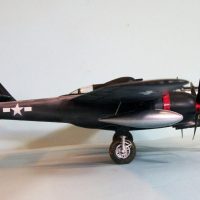
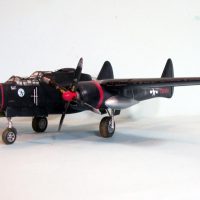
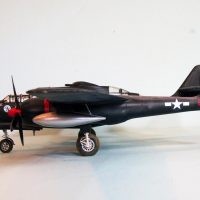
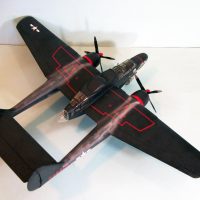
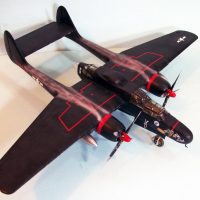
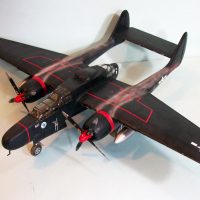
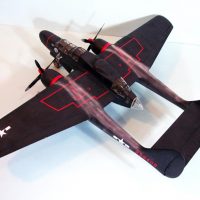
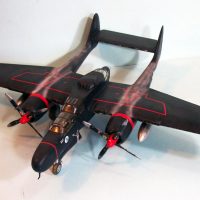
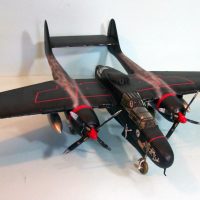
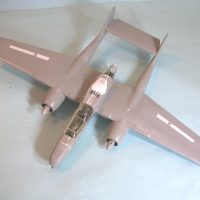
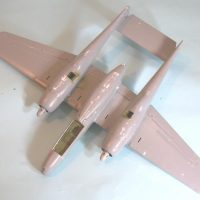
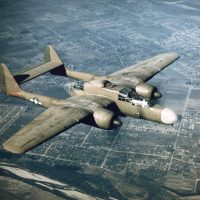
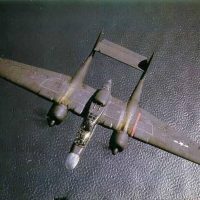
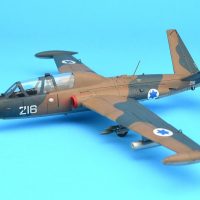
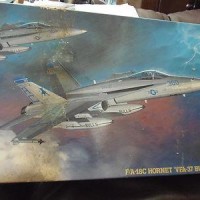
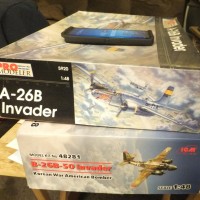
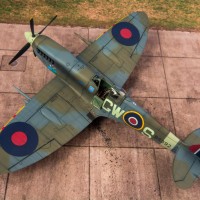
Excellent result upon overcoming quite a few kit issues, my friend @tcinla!
I have already built Monogram's "Lady in the Dark" and have another Monogram to build (that I bought for just $15 new). Still in love with it, I am going to build it one day, not terribly missing the GWH kit...
As usual, nice and very informative article.
Thanks for the info Tom. Very nice result regardless of accuracy. Years ago I muddled my way through the Monogram kit and was quite happy with the result despite all the filling and sanding and resultant loss of detail. Many shades of black can hide a multitude of flaws! It still survives at the back of the display case.
Great build, Tom
The outcome of your build does not show this is a dissapointed kit.
Your skills definitely turned this kit into a very nice P61.
Interesting points, Tom. I may have to give that old Monogram kit in the stash a go one of these days. The only P-61 that I ever built was the Airfix kit back in the ‘70s.
For those considering the GWH kit, @eb801 posted over on Walt B's WIP some information about corrected GWH models:
GWH did make a lot of corrections. The props have been corrected but unfortunately, not the cowlings or the cowl flaps. (Victor and Eduard replacements are worth looking into.) The canopy has been corrected with a new sprue of clear parts. Also a new fuselage replacement sprue with the proper crank case engine covers and magnetos. These corrections were actually done in time for GWH’s 2012 release of the P-61A “Glass Nose” kit with the turret.
Tom: In that last color photo taken from above, I notice the turret has only two guns.
Is Modelshack still around? I could not find any online presence.
It's got 4 guns - look again, it's dark against darker. Don't know about Modelshack.
After checking that photo again in the SquadronSignal book "Evolution of the P-61 Black Widow" pg. 14, the caption reads "This YP-61 was used to test a two-gun .50 caliber turret while seeking a solution to the turret buffeting".
Oh! You're not talking about the model!
(Emily Litella voice): Never mind.
As much as I like P-51B's you might wanna fix your title for future googling's sake.
Wouldn't want anyone looking for P-61 info to miss this.
Great stuff as always Tom.
I HATE HATE HATE typozzzzzz... 🙂
Great work and info!
Thanks for the info Tom. I have the old Monogram kit (yes, not the Revell 🙂 ) and after your post I think I'll keep it.
Very nice Tom! Besides the history to give, one of the main reasons I like your write-ups is the play-by-play of the build which helps me avoid the built in minefields of the kits. No need to waste time trying to fix a problem when you have already provided an easy solution. Thanks a bunch!